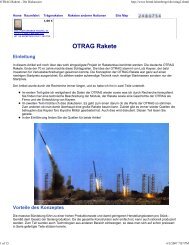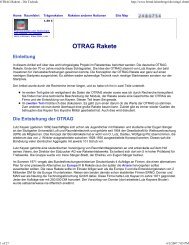Create successful ePaper yourself
Turn your PDF publications into a flip-book with our unique Google optimized e-Paper software.
Another argument should be relatively cheap insurance against civil liability for personal<br />
injury. In Libya, he was then confronted, that the military was interested in his rockets.<br />
As a result, were then made only starts with a module. When Kayser refused to go on a<br />
two-stage version, he was dispossessed. As far as the description Kayser.<br />
Researched it on the internet it is considered by most sources as a foregone conclusion<br />
that it has developed rockets for the military in Libya. I would like to once again face the<br />
facts and possible explanations. The basic problem is that there are contradictions that<br />
can be interpreted either way.<br />
* The activities of a military missile program, says that even admits himself that from<br />
the beginning Kayser stated in Libya desires of the military. One wonders why he has not<br />
time to leave the country again. However, confirmed a report by the magazine<br />
"Transatlantic" from August 1980, when a journalist long time Kayser, accompanied him<br />
a "remarkable political naivety".<br />
* For a participation in a military program, the fact that Kayser was expropriated.<br />
However, employees were working then and only Kayser and part of the team left Libya.<br />
The employees resigned from the <strong>OTRAG</strong> and were paid by Libya.<br />
* The expropriation is probably the most puzzling in all of history. As a company<br />
expropriated and then terminate employees at this and continue working for the Libyan<br />
military. Kayser, who was dispossessed, but has another 10 years resident in Libya. In<br />
2002 he was speaker of the Libyan Academy of Sciences.<br />
* For most suspicious that the move to Libya, ending the public. Most independent<br />
sources of lead only the first start in Libya on 03/03/1981. After that there is no more<br />
information. This is for a company that relies on funds from shareholders, not conducive.<br />
* 4 module untenBei the starts they made a step back from 4 to 1 module. Even here<br />
there are two explanations. First, Kayser says, that they wanted to test different<br />
parameters and this was just as good with a module. In a two-stage version would be in<br />
conflict with the MTCR (prohibition of exports of missiles over ranges of 300 km in<br />
developing countries). come. For a missile of strategic importance but a module would<br />
have been better, because it is easier to handle.<br />
* It can be found in Kayser's list some odd starts as of the start in the 60 degree angle.<br />
Thus, most started artillery rockets. Kayser said the program can save by a pitch to the<br />
missile and thus would not fall on the grid. There are even Japanese rockets Sun started,<br />
but these are pure solid fuel rockets with limited possibilities for control. The rocket<br />
should <strong>OTRAG</strong> but use a different concept of control. Subsequent tests of Libya, that<br />
shows a log made available to me were only 1 module tests in oblique angles. At 50%<br />
filling degree and 70 degree inclination ereichte to distances of 50-70 km. If one were<br />
transferred to this ideal. (45 degree firing, full tanks), a module would achieve the same<br />
payload with a range of 170 km. That range would be larger than that of any<br />
Artelleriegeschosses.















